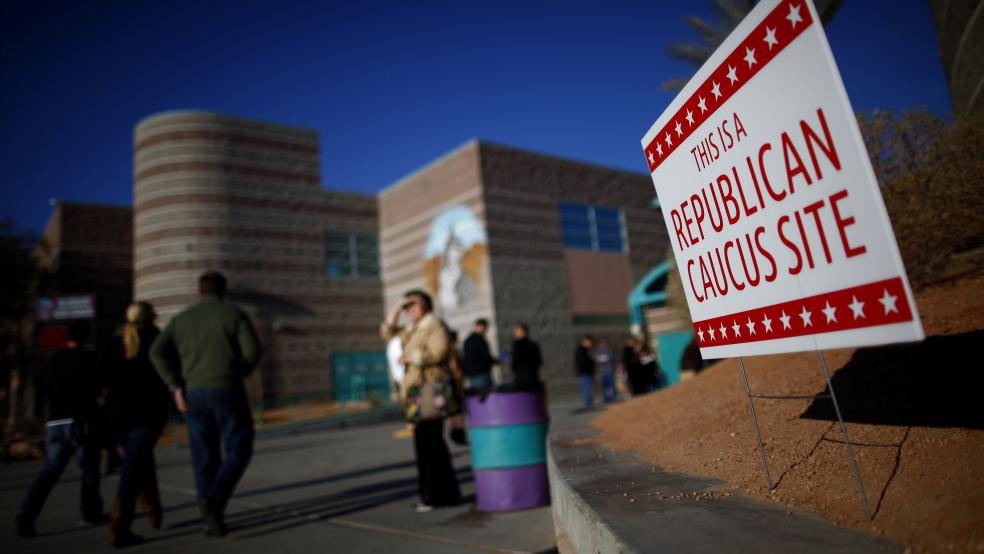Presidential candidates from both parties have been crisscrossing the Hawkeye State, trying to connect with voters before the first-in-the-nation Iowa caucuses on Monday.
Why is Iowa such a big deal? Why have so many candidates logged so many miles there, answering questions and shaking hands in small, unheated barns and large, packed rallies? And what’s a caucus anyway?
Here’s what you need to know about the quadrennial phenomenon that is the Iowa caucuses.
Related: How Trump Could ‘Run the Table’ if He Beats Cruz in Iowa
What are the Iowa caucuses?
They’re public gatherings of Republicans and Democrats in each of Iowa’s 1,681 precincts, typically in church basements or high-school gyms, to discuss and cast ballots for the various candidates. The caucuses aren’t actually elections — state and local governments administer those. Instead, these meetings are conducted by the state’s Democratic and Republican parties.
The caucuses are just the first step in a complicated process for allotting electoral delegates in Iowa. They draw a lot of media atttention because they are often seen as the first clear evidence of a candidate’s success or failure in the race for the presidential nomination.
Why was Iowa chosen to go first?
It wasn’t chosen. Back in 1972, Iowa Democrats pushed their caucus back from the spring to Jan. 24, an earlier date than usual, because of scheduling issues. Iowans enjoyed the increased press coverage they received for holding the first contest on the road to the White House, and in 1976 the Republicans moved their caucuses back to the same day in order to create a unified event that would receive maximum media attention.
Being first is such a big deal in the state that the Iowa legislature requires that the state’s caucuses come before all other presidential nominating contests by at least eight days.
Related: Want Better Candidates? Stop Holding Early Votes in Iowa and New Hampshire
How do the caucuses work?
On Feb. 1, voters in Iowa will head to one of the 1,681 precincts across the state at 7 p.m. Central Time to finally kick off the presidential nomination process.
The Republican process is pretty simple. Once a precinct meeting has begun, attendees speak on behalf of candidates. Sometimes candidates will even come and speak to the crowd. After the speeches, a secret ballot vote is conducted and the totals are tallied statewide.
The Democratic system is more complicated. Voters stand in groups with other supporters of their chosen candidate and are counted. If one candidate fails to receive at least 15 percent of the votes, he or she is eliminated and the supporters choose another candidate. Voters typically try to entice people to join their groups. After that, delegates are assigned based on the support that each candidate receives.
Once the caucuses are complete and the votes collected, the results are reported to the state parties, which will then tabulate the numbers and report them to the media.
This year, a new digital app will be reporting precinct votes, the result of a collaboration between the Republican and Democratic parties of Iowa and Microsoft. The app is intended to improve reporting and avoid inaccuracies in data, like in 2012, when the Republicans mistakenly declared Mitt Romney the winner. Two weeks later, updated counts showed Rick Santorum had eked out the win.
The campaign for Democratic presidential candidate Sen. Bernie Sanders has raised suspicions over the app, wary of such a large corporation’s involvement and noting that Microsoft employees have donated hundreds of thousands of dollars to Hillary Clinton’s campaign.
How many Iowans participate in the caucuses?
Any Iowan who is registered to vote and will turn 18 before the election can register as either a Democrat or Republican and participate in that party’s caucus. Independents must re-register as either a Democrat or Republican in order to participate.
Roughly one-fifth of eligible voters turn out to vote on caucus night — usually a little over 100,000 people per party — while the vast majority of independent voters usually don’t show up. The Iowa Voter registration records list 584,111 active registered Democrats and 612,112 active registered Republicans. Around 20 percent of registered Republicans showed up for the 2012 and 2008 caucuses. In 2008, about 40 percent of registered Democrats participated in the caucus, while only 23 percent did in 2004.
The takeaway for candidates: Turnout really matters, as just a handful of votes could make a huge difference.
Many critics cite these numbers as evidence that a small portion of the population receives outsized attention and is given undue influence in the presidential race. On the other side, proponents of the system say that the caucuses give candidates who don’t have a lot of money behind them a real shot in the election and help counterbalance the financial advantages of large super PACs.
Do the caucuses really matter?
The candidates who win in Iowa do receive a boost in the media, and in turn, increased attention from voters. If a candidate performs badly, support and fundraising begins to dry up, winnowing the field. For the most part, the Iowa caucuses identify the clear campaign losers rather than predicting the winner.
They also carry limited weight as part of the state process of selecting Electoral College delegates. The precinct caucuses are followed by county conventions and congressional district conventions, which then lead to a state convention in the spring in which all of the state’s national delegates are chosen. These national delegates are the ones who attend each party’s national convention and formally nominate the party’s candidate. The precinct caucuses are merely the first step in this process for Iowans.
How often have Iowans selected the eventual nominee?
The track record is definitely mixed. The last time Iowa Republicans picked the eventual nominee was in 2000, when George W. Bush won the caucuses. Bob Dole won in Iowa en route to the nomination in 1996. But candidates who lost in Iowa wound up winning the party’s nomination in 1980, 1988, 2008 and 2012. In all, Iowa winners have gone on to clinch the nomination in just three of the last seven contested caucuses.
Related: Trump’s Big Weakness in Iowa – and What He Plans to Do About It
On the Democratic side, Al Gore (2000), John Kerry (2004) and Barack Obama (2008) all won in Iowa on their way to the nomination. The upset wins by Kerry and Obama helped solidify their standing as candidates. But in 1992, the eventual Democratic nominee, Bill Clinton, was trounced by Iowa Senator Tom Harkin. Clinton won only 2.8 percent of the delegates, while Harkin won 76.4 percent. In 1988, Dick Gephardt won Iowa but Michael Dukakis eventually became the party’s nominee.
Again, while Iowa may not always pick the eventual winner, it does help to separate contenders from pretenders. Since 1972, no candidate who has finished outside the top four in Iowa has won their party’s nomination.





